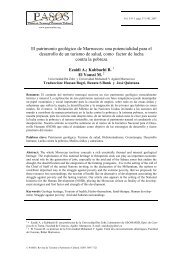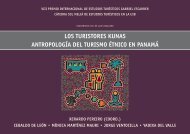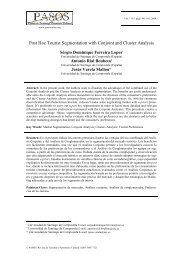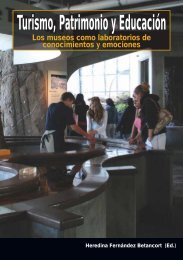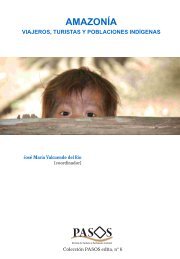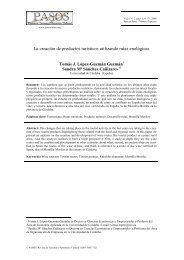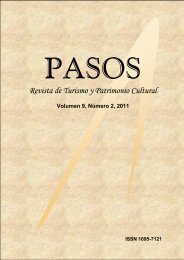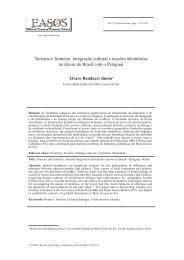Full Journal - Pasos
Full Journal - Pasos
Full Journal - Pasos
Create successful ePaper yourself
Turn your PDF publications into a flip-book with our unique Google optimized e-Paper software.
98 Repositioning of Barcelona’s Image in the Light of a Redefinition of the Urban Tourism Planning Model<br />
better clients for the city rather than just more<br />
of the same. This approach is needed to sustain<br />
growth and delay market maturity, we crossed<br />
city use with the value contributed by each<br />
group of clients (see Figure 4). The following are<br />
strategic clients:<br />
––<br />
The first block comprises those who live and<br />
work in Barcelona and those who live and<br />
work outside the city. These are the main<br />
clients, who use the city intensively and add<br />
the greatest value. Furthermore, they form<br />
part of the city’s cultural identity. Two main<br />
aspects need to be managed in connection with<br />
this group: (1) it is important they do not feel<br />
left out; (2) they benefit from tourism and see<br />
it as contributing to the city’s development.<br />
Failure to enlist the support of this internal<br />
public means no tourist city.<br />
––<br />
The second strategic block comprises ‘city<br />
break’ travellers spending short spells for<br />
health, sports or business reasons. These visitors<br />
add a lot of value to Barcelona while using<br />
the city much less intensively and hence are<br />
highly profitable. This external group is vital<br />
for projecting Barcelona’s brand image.<br />
––<br />
The third block of strategic clients consists of<br />
those making long stays for training, entrepreneurial,<br />
and research purposes. They are<br />
among those adding most value to the city and<br />
make somewhat greater use of it. This external<br />
group is also vital for projecting Barcelona’s<br />
brand image.<br />
The planning process needs to give special<br />
consideration to these strategic clients, without<br />
of course ignoring the rest who also city clients.<br />
Given knowledge of the client hierarchy, this<br />
takes us on to building the right portfolio for<br />
this clientele: culture; business; sports; cruises;<br />
knowledge; innovation; shopping; architecture<br />
and design; city breaks; university centre (‘The<br />
European Boston’); health; beaches; gastronomy.<br />
We have selected the attributes that best<br />
suit these strategic internal and external clients<br />
(Figure 5). These attributes are proposed for<br />
the repositioning of Barcelona’s brand image, in<br />
order to compete in the new, more demanding<br />
environment of the great tourist destination<br />
cities. The list is also in line with the proposals<br />
put forward by internal players:<br />
––<br />
Knowledge<br />
––<br />
Innovation and attracting top talent<br />
––<br />
Culture<br />
––<br />
Business and entrepreneurship<br />
––<br />
City Breaks<br />
––<br />
Cruises<br />
Figure 4: City clients<br />
PASOS. Revista de Turismo y Patrimonio Cultural, 11(1). 2013 ISSN 1695-7121



